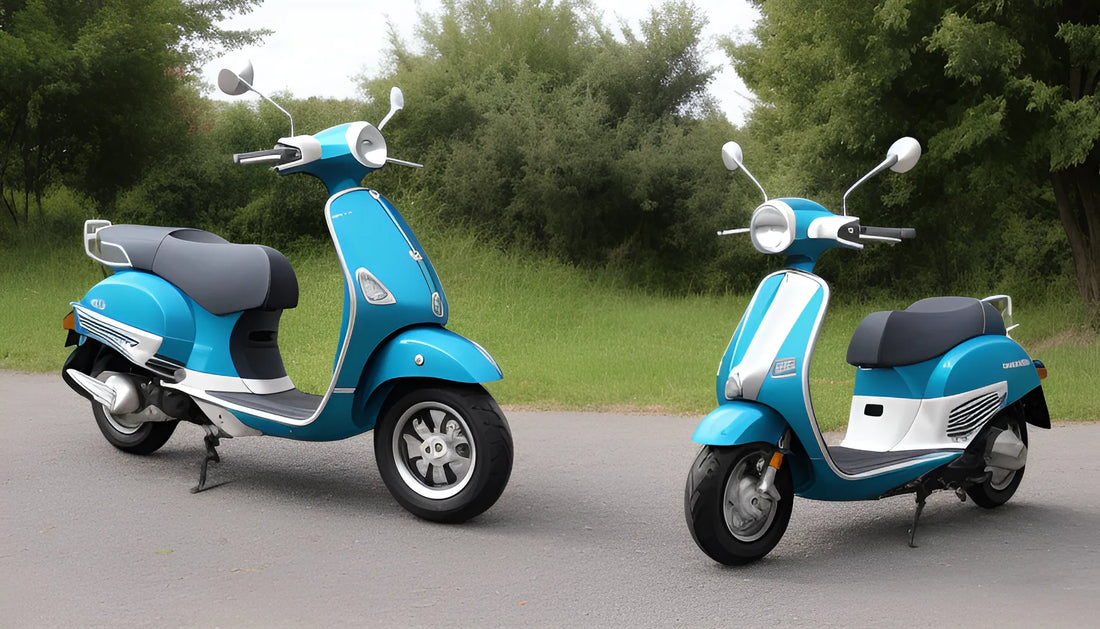
How to Properly Store a Gas Powered Motor Scooter for Winter
Jeremy KuehniShare
Properly Store a moped or Scooter for Winter
Winter is just around the corner, and if you own a gas-powered motor scooter, it's essential to know how to store it properly during the colder months. By taking the necessary steps to winterize your scooter, you can ensure its longevity and keep it in top condition for the next riding season.
Step 1: Clean and Prep
Before storing your gas-powered motor scooter, it's crucial to give it a thorough cleaning. Wash and dry the exterior, paying attention to remove any dirt, debris, or road salt. This step prevents corrosion and keeps your scooter looking its best.
Next, change the oil and filter. Old oil can become acidic over time, causing damage to the engine. By replacing the oil and filter, you'll protect the internal components and ensure smooth operation when you take your scooter out of storage.
Step 2: Fuel System
Properly handling the fuel system is vital to prevent clogs and other issues. Start by adding a fuel stabilizer to the gas tank according to the manufacturer's instructions. This stabilizer prevents the fuel from deteriorating and clogging the carburetor.
Once the stabilizer is added, run the scooter for a few minutes to circulate the treated fuel throughout the system. This step ensures that the stabilizer reaches all the necessary components.
Additionally, it's recommended to drain the carburetor to remove any residual fuel. This prevents varnish buildup and ensures a clean start when you're ready to ride again. Consult your scooter's manual for specific instructions on how to drain the carburetor.
Step 3: Battery Maintenance
During the winter months, it's common for batteries to lose their charge. To prevent this, either remove the battery from your scooter or connect it to a battery maintainer. A maintainer will keep the battery charged without overcharging it, ensuring it's ready to go when you take your scooter out of storage.
If you choose to remove the battery, store it in a cool and dry place. Make sure to keep it away from any flammable materials and check the battery periodically to ensure it doesn't lose its charge completely.
Step 4: Storage Environment
Find a suitable storage location for your scooter. Ideally, it should be a dry and cool area, away from extreme temperatures and direct sunlight. If possible, store your scooter indoors to provide additional protection from the elements.
Before parking your scooter, raise it on a center stand or use a rear stand to relieve pressure on the tires. This helps prevent flat spots from forming on the tires during the extended period of inactivity.
Use a breathable cover to protect your scooter from dust and moisture. Avoid using plastic or non-breathable covers, as they can trap moisture and lead to rust or mold growth. Ensure that the cover fits properly and secure it to prevent it from being blown away by strong winds.
Step 5: Regular Maintenance
While your scooter is in storage, it's important to perform periodic maintenance. Check the tire pressure regularly and inflate them to the manufacturer's recommended levels if needed. This helps prevent sidewall cracking and maintains proper handling when you start riding again.
Lubricate any exposed metal parts, such as the kickstand and hinges, to prevent rust. Apply a thin layer of corrosion-resistant lubricant to these areas to protect them during the storage period.
Additionally, start the scooter and let it run for a few minutes every couple of weeks. This helps keep the internal components lubricated and prevents them from seizing. Make sure to do this in a well-ventilated area to avoid carbon monoxide buildup.
Step 6: Documentation and Insurance
Before storing your scooter, ensure that all documentation, including registration and insurance, is up to date. It's also a good idea to take photos of your scooter from various angles. These photos can be helpful in case of any damage or theft during the storage period.
Step 7: Additional Tips
Here are some additional tips to ensure the proper storage of your gas-powered motor scooter:
- Remove any accessories or detachable parts that are not securely attached to the scooter. Store them separately in a safe place.
- Check all lights and signals to ensure they are in proper working order. Replace any burnt-out bulbs before storing the scooter.
- Consider using a fuel stabilizer that also protects against ethanol-related issues if you live in an area where ethanol-blended fuel is common.
- Inspect the drive belt or chain and lubricate if necessary. This will help maintain proper tension and prevent rust during storage.
- If your scooter has a carburetor, consider using a fogging oil to protect it from corrosion. Follow the manufacturer's instructions for proper application.
Conclusion
Properly storing your gas-powered motor scooter for winter is essential to maintain its performance and extend its lifespan. By following these steps and additional tips, you can ensure that your scooter will be in excellent condition when you're ready to hit the road again in the spring. Remember, taking the time to properly winterize your scooter now will save you time and money on repairs in the future.
